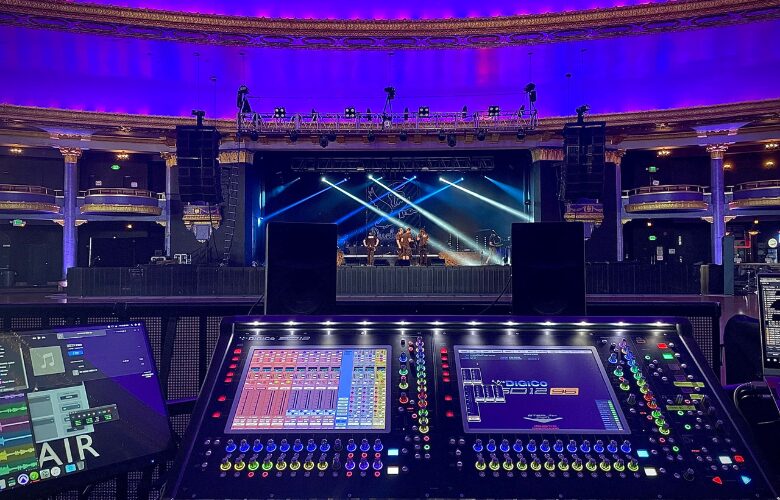
With each tour I’ve been a part of, a few checklist items help me be successful at FOH regardless of the size of the show.
A friend last year asked what it was like mixing such a vast mixture of venues, and how I maintained consistency while still searching for the last 1%. For context, we were jumping between Soldier’s Field, The Eagles Room, and outdoor venues. It was tough to paint the same sonic image every day, so I had to quickly employ a variety of organizational techniques and become pretty analytical of many elements to achieve that goal.
That experience has come in handy since, giving me tools to tackle both acoustically challenging venues and shows where every variable in my control hasn’t been consistent.
This spring I’ve been mixing on consoles of the day in small clubs, which offers a new set of challenges. Oftentimes I’m battling heavy stage volume, and dealing with consoles of the day and PA of the day makes it challenging to create the same auditory experience for the audience.
This is a glance at how I tackle the change in environments, first from a procedural and organizational perspective.
When using the venue’s house console, I familiarize myself before show day with YouTube, manuals, and other resources. Offline editors are also helpful for building a baseline so I can maximize time making noise.
On this tour, I’ve been lucky enough to use the same console two or three times. In these cases, I make sure I reset the output EQs and matrices so I can start fresh for the space.
If you’re touring on a dedicated show file, don’t be afraid to make adjustments as you progress. For the tour I was a part of last year, I had a stadium show file, my baseline show file, and something else to provide a starting point for clubs and weird venues. I also occasionally altered master bus processing depending on the line array being used, to maintain an expected depth of field among instrumentation and vocal clarity. This of course took time to organize, and I had notes to keep myself accountable. Also, changes between files were never big but were just enough to make sure I could deliver the same sonic experience.
Lastly, proper file organization goes a long way. Label your files with date, location, and other pertinent info so you have the most up-to-date changes available to you. I usually have a “start” and “end” to refer to.
My show files also generally follow a template I’ve created for myself. I have specific ways I prefer to use groups, VCAs, FX, and parallel busses that let me quickly set up an impactful and transparent mix.
Listen to your PA as much as possible. Walk around the room and get a feel for what’s happening outside of FOH. Play your reference tracks, play a variety of them if you have time. Use Smaart and then your ears to tune the system to your target curve and adjust for tonality. Ask the local tech or SE for their input on the system and room, but also listen to the behavior of the equipment and the acoustics for yourself.
Another favorite, resources permitting, is to use multi tracks for virtual soundcheck if possible. If this is not a viable option, spending ample time with each input during line check can also go a long way.
These starting points are like a compass for tackling a myriad of situations at FOH. They let me stay flexible and also quickly build a mix or give me time to ensure my mix sounds the way I intend.


The mission of SoundGirls.org is to inspire and empower the next generation of women in audio. Our mission is to create a supportive community for women in audio and music production, providing the tools, knowledge, and support to further their careers. SoundGirls.Org was formed in 2013 by veteran live sound engineers Karrie Keyes and Michelle Sabolchick Pettinato and operates under the Fiscal Sponsorship of The California Women’s Music Festival, a 501(c)3 non-profit organization. In 2012, Karrie and Michelle participated in the “Women of Professional Concert Sound” panel at the AES Conference in San Francisco. The panel was hosted by the Women’s Audio Mission (WAM) and moderated by WAM founder Terri Winston. Terri brought together five women working in live and broadcast audio. The groundbreaking panel (which also included Jeri Palumbo, Claudia Engelhart and Deanne Franklin), provided young women and men a glimpse into life on the road, tips and advice, and a Q & A with the panelists. More importantly though, was how incredibly powerful the experience was for the panelists. We had all been in the business for 20 years or more, yet most of us had never met before that day and within minutes we bonded like long-lost sisters. We were struck by how similar our experiences, work ethics, and passions were and wondered why our paths had never crossed and how our careers would have been different had we been there to support each other through the years. Each of us are strong on our own, but together we were even stronger and a powerful force. We were empowered. Each of us had been asked hundreds of times in our careers: Are there other women doing sound? How did you get into sound? How would a young woman go about getting into sound? Through creating SoundGirls.Org, we hope to establish a place for women working in professional audio to come for support and advice, to share our success and failures, our joys and frustrations, and for empowerment and inspiration.
Read Full Profile© 2021 TheatreArtLife. All rights reserved.

Thank you so much for reading, but you have now reached your free article limit for this month.
Our contributors are currently writing more articles for you to enjoy.
To keep reading, all you have to do is become a subscriber and then you can read unlimited articles anytime.
Your investment will help us continue to ignite connections across the globe in live entertainment and build this community for industry professionals.